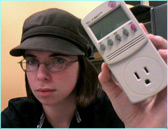I have one of those ultra portable laptops that uses an efficient solid-state hard drive, and isn't much bigger than a hardcover book.
My measurements (taken with the ammeter, just like yesterday's toaster reading) came out to a current of 1.1 amps. According to the formula I used yesterday (Volts x Amps= Watts), the laptop was using 132 Watts. But my friend pointed out that the AC/DC adaptor for the laptop can't draw more than 36 watts! (It says so on the back.)
I wasn't sure what was going on, so I decided to try to get a reading with my backup tool--the kill-a-watt meter pictured with me in the sidebar. The kill-a-watt is just another power meter. It's more...how do I put this... user-friendly than the ammeter. It converts current and voltage into watts and even tracks power use over time and calculates kilowatt-hours for you.
The kill-a-watt gave a much more reasonable reading--0.42 amps. But that's still more current than the laptop can handle. And the Watts readout didn't equal the Volts times Amps. This makes me very nervous.*
Here's the bottom line:
I'm going to need some help to figure this out. So tonight I'm packing my small appliances into a sack and heading to meet some friends who have more sensitive tools over at MIT. Wish me luck.
*This whole affair makes me nervous about yesterday's breakfast measurements. So I tried the measurement again this morning, using both the ammeter and the kill-a-watt in turn to see if they'd disagree again. This time, they agreed. I also went to a few external sources to check my numbers against the manufacturer's, and the values I got for the toaster seem right. It looks like the measurement problem only shows up for devices that draw a small amount of power. How small? I'm not sure.
I know I promised a post on green computing today, but I'm afraid that's on hold until I figure this out.


first, you did not say if you have 120 volts or like in my area it is down graded to just above 110 volts.
next did you remove the battery...it maybe trying to charge it. you may also have to park the hard drive just like you were to go on a trip....my guess is that it was not running during the makers testing.
during the makers testing was the back light dim?
give some of these ideas a try.
Oh YA! forgot to mention you can not have any wifi or blue-tooth turned on.
@eaamon
Sorry for leaving that out. The volts reading at the wall socket was just over 120.
Rachel
sorry forgot you noted a solid state drive.
AC power calculations differ from DC power calculations. DC power is indeed volts times amps. For AC circuits, one also needs to know the phase angle between the voltage and current.
In AC, apparent power is equal to volts times amps and is labeled volt-amps (VA). Real power is VA times the cosine of the phase angle between the voltage and current.
From wikipedia:
http://en.wikipedia.org/wiki/Power_factor
In a purely resistive AC circuit, voltage and current waveforms are in step (or in phase), changing polarity at the same instant in each cycle. Where reactive loads are present, such as with capacitors or inductors, energy storage in the loads result in a time difference between the current and voltage waveforms. This stored energy returns to the source and is not available to do work at the load. Thus, a circuit with a low power factor will have higher currents to transfer a given quantity of real power than a circuit with a high power factor. A linear load does not change the shape of the waveform of the current, but may change the relative timing (phase) between voltage and current.
Circuits containing purely resistive heating elements (filament lamps, strip heaters, cooking stoves, etc.) have a power factor of 1.0. Circuits containing inductive or capacitive elements (lamp ballasts, motors, etc.) often have a power factor below 1.0.